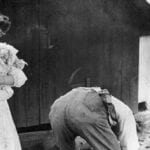 Weird Stuff
Weird Stuff  Weird Stuff
Weird Stuff  Our World
Our World 10 Ways Your Christmas Tree Is More Lit Than You Think
 Movies and TV
Movies and TV The 10 Coolest Stars to Set Sail on The Love Boat
 History
History 10 Things You Didn’t Know About the American National Anthem
 Technology
Technology Top 10 Everyday Tech Buzzwords That Hide a Darker Past
 Humans
Humans 10 Everyday Human Behaviors That Are Actually Survival Instincts
 Animals
Animals 10 Animals That Humiliated and Harmed Historical Leaders
 History
History 10 Most Influential Protests in Modern History
 Creepy
Creepy 10 More Representations of Death from Myth, Legend, and Folktale
 Technology
Technology 10 Scientific Breakthroughs of 2025 That’ll Change Everything
 Weird Stuff
Weird Stuff Ten Bizarre Facts About The Doge Meme
 Our World
Our World 10 Ways Your Christmas Tree Is More Lit Than You Think
 Movies and TV
Movies and TV The 10 Coolest Stars to Set Sail on The Love Boat
Who's Behind Listverse?

Jamie Frater
Head Editor
Jamie founded Listverse due to an insatiable desire to share fascinating, obscure, and bizarre facts. He has been a guest speaker on numerous national radio and television stations and is a five time published author.
More About Us History
History 10 Things You Didn’t Know About the American National Anthem
 Technology
Technology Top 10 Everyday Tech Buzzwords That Hide a Darker Past
 Humans
Humans 10 Everyday Human Behaviors That Are Actually Survival Instincts
 Animals
Animals 10 Animals That Humiliated and Harmed Historical Leaders
 History
History 10 Most Influential Protests in Modern History
 Creepy
Creepy 10 More Representations of Death from Myth, Legend, and Folktale
 Technology
Technology 10 Scientific Breakthroughs of 2025 That’ll Change Everything
10 Ludicrous Laws from the Middle Ages That We Still Break Today
The Middle Ages spanned from roughly AD 500 to AD 1500. It was a period filled with famine, plague, and war. Ruled by the king, the people of medieval England lived under a feudal system heavily influenced by the Roman Catholic Church.
During the Middle Ages, both laws and the penalties for breaking them were very different from the ones we are familiar with today. From football being outlawed to the practice of witchcraft being punishable by death, here are ten ludicrous laws from the Middle Ages that, thankfully, are no longer in place.
Related: Top 10 Ridiculous Laws That Are Still Enforced Across The World
10 Playing Football Was Forbidden
While football players today have a reputation of being dramatic over the smallest of injuries, their predecessors were the exact opposite. Medieval football was a violent game. While there were not as many rules, there was a lot more bloodshed. Rather than a ball, an inflated pig’s bladder was kicked up and down the entire length of a village, with the goals sometimes miles apart. Players could kick and punch both the bladder and their opponents, resulting in many injuries and the occasional death.
Football was banned in 1349 by Edward III, not because he was concerned about public health but rather about national security. Not only was England at war with France in 1349, but the country was also suffering the loss of many lives due to the Black Death, a global epidemic of the bubonic plague. Edward III wanted his remaining, healthy men to be focused on their archery practice rather than getting distracted by football. The punishment for playing football was six days imprisonment.[1]
9 Blowing One’s Nose Was Illegal
Newmarket, a town in the English county of Suffolk, is known as the birthplace of horse racing. The practice dates back to the 12th century, but James I popularized it after building a palace there in 1606, which drew in a lot of people.
Over time horse racing in Newmarket grew into a large business, and the town was forced to establish laws to protect the horses, including one that made it illegal for people to blow their noses in the street. This was to reduce the risk of the horses getting sick. What a nightmare it must have been for people with hay fever!
Blowing one’s nose wasn’t the only thing that could get a person in trouble. Anyone walking around with a head cold or temperature had to pay a fine. Obviously, Horse racing was a serious business.[2]
8 You Had to Have Your Master’s Permission to Get Married
Today, it’s daunting enough having to ask the father of your partner for their child’s hand in marriage. While this practice is done out of respect, the answer given does not decide your future, and you can still get married—even if the father does not give his blessing. This, however, was not the case in the Middle Ages.
Societal rank played a large role in medieval life, especially for those at the bottom of the pyramid. Peasants and serfs working and living under landowners essentially had no freedom. A man wanting to get married not only had to get the father”s permission but also their landowner’s.
For a woman, the situation was even worse. If her husband died, the landowner could force them to marry another man in a relatively short amount of time. If they refused, they could receive punishment. [3]
7 Wearing Long, Pointy Footwear Was Forbidden
Fifteenth-century Britain was a time of flamboyance. Along with short shirts, long, pointy-ended shoes known as crackows, or pikes, had become the height of men’s fashion. It was believed that the longer the toe, the more masculine and rich the wearer, so much so that shoes sometimes extended up to five inches beyond the toe. This led to the ends occasionally having to be tied around the wearer’s ankles.
As the fashion continued growing and peasants began wearing more extravagant clothing, the English crown finally decided to step in. They wished to preserve the feudal hierarchy and stop people from dressing above their social rank. Between 1463 and 1604, a law passed that said that “No knight under the rank of a lord, esquire, or gentleman, nor any other person, shall wear any shoes or boots having spikes or points which exceed the length of two inches.” The punishment was a fine of three shillings and four pence, which is just over US$136.[4]
6 People Could No Longer Eat More Than Two Courses
In the Middle Ages, there were many sumptuary laws that restricted what people could eat and drink. They were intended to reduce excessive eating and prevent people of lower social status from matching the lifestyles of those above them.
In 1336, a law banned that people, no matter their rank, shall be served a meal with no more than two courses. Soup, it made sure to specify, counted as a full course meal and wasn’t just a sauce. The exception to the law was on certain festivals, such as Christmas, where three courses were allowed.[5]
5 Commit a Crime, Go through an Ordeal
In medieval England, the peasants had strength in their numbers. To stay in power and prevent revolts, the upper-class authorities made it so that even the smallest of crimes committed had harsh penalties. The idea of this was to make the poor fear stepping out of line. Even petty crimes (theft, disturbing the peace—which often meant the king—or vagrancy) sometimes resulted in harsh punishments, from flogging to having some part of the body cut off (hands were quite common). Until 1215, even being accused of a crime resulted in the punishment of enduring an ordeal that revealed a person’s innocence or guilt.
There were three ordeals:
Ordeal by fire: The accused held a red-hot iron bar in their hands and walked three meters. After three days of being bandaged up, the wound on the hand would be looked at to determine the accused’s fate. If it was healing, they were innocent; if it wasn’t, they were guilty.
Ordeal by water: The accused was tied up and thrown into a body of water. If they sank, they were innocent. If they floated, it was seen that the river had not accepted them, and, therefore, they were guilty.
Ordeal by combat: This was combat between the accused and accuser. It was believed that God would give strength to the innocent. It must be noted that the fight often ended in the loser’s death.
The practice of ordeals was declared over by the Pope in 1215 and was replaced by a jury process.[6]
4 No Sex on Certain Days of the Week
Throughout the Middle Ages, there were a number of religious laws that tried to restrict when a person could have sex. In an average seven-day week, a married couple could only have sex on four of the days. Days in which sex was prohibited included Thursday and Friday because people were supposed to prepare for Holy Communion and Sunday—because it was the Lord’s day.
And that wasn’t all. Throughout the year, there were many other periods where sex was banned, including 47 to 62 days during Lent, the 35 days before Christmas, and the time around the Feast of Pentecost, which could be anywhere from 40 to 60 days.
Medieval people believed that eye contact was an important part of sexual attraction. It was said that “the eye was not a passive receiver but was instead active in sending out rays of sight toward the object of vision. The very act of looking could stimulate desire in the observer and the observed.” Women were advised to be careful about when they looked at men—so as to not tempt them at the wrong time.[7]
8 Playing Tennis Was Forbidden
Football wasn’t the only sport banned in the Middle Ages. In 1485, it became illegal for young men who weren’t nobles to play tennis, with the only exception being on Christmas day. Medieval tennis was believed to disrupt labor and encourage gambling in workers because participants were left in unsupervised situations without their masters around.
The banning of tennis in the lower classes helped to maintain the feudal hierarchy. Tennis began to be seen as an exclusively upper-class sport because it needed expensive equipment and required an understanding of complex rules and social etiquette.
Tennis eventually became known as “the sport of kings,” with Henry VII and Henry VIII both apparently very into the game. A Venetian Ambassador who watched Henry VIII play in his youth said, “It was the prettiest thing in the world to see him play; his fair skin glowing through a shirt of the finest texture.” Thankfully today, tennis can be played by all.[8]
2 Blasphemy Resulted in the Loss of One’s Tongue
In the Middle Ages, people had to watch their tongues, both physically and metaphorically, to avoid breaking the religious law regarding blasphemy, the action of speaking ill about God or sacred things. The law was put in place by the medieval Catholic Church to maintain control and order.
The church viewed blasphemy as a severe crime and gave it an equally severe punishment. The penalty for blasphemers was harsh. Often a person would be bound and tied while their tongue was removed with hot pliers, leaving them mute for the rest of their lives. Other punishments included stoning and hangings.[9]
1 Practicing Witchcraft Was Punishable by Death
In the Middle Ages, people did not understand how many things worked around them, especially natural phenomena, as much was unknown to the scientific world. Humans, in general, do not like uncertainty, and the people of the Middle Ages were no different. Usually, God was their answer for things that could not be explained. However, when it came to naturally occurring ill-fortunes such as sickness, bad harvests, and the deaths of animals, they blamed witches because God, in their eyes, could not do evil.
Witches were believed to be able to summon evil spirits and demons, but in reality, they were usually just poor, elderly women who owned a cat. While widespread witch trials throughout Europe didn’t reach their peak until the late fifteenth century, certain women were ostracized and punished when seen as different.
In 1542, the Witchcraft Act was passed by parliament and established that witchcraft was a crime punishable by death. Witch-hunting became huge after that, especially in southeast England, and it is believed that over 500 people were put to death between the 15th and 18th centuries.[10]








